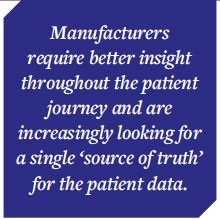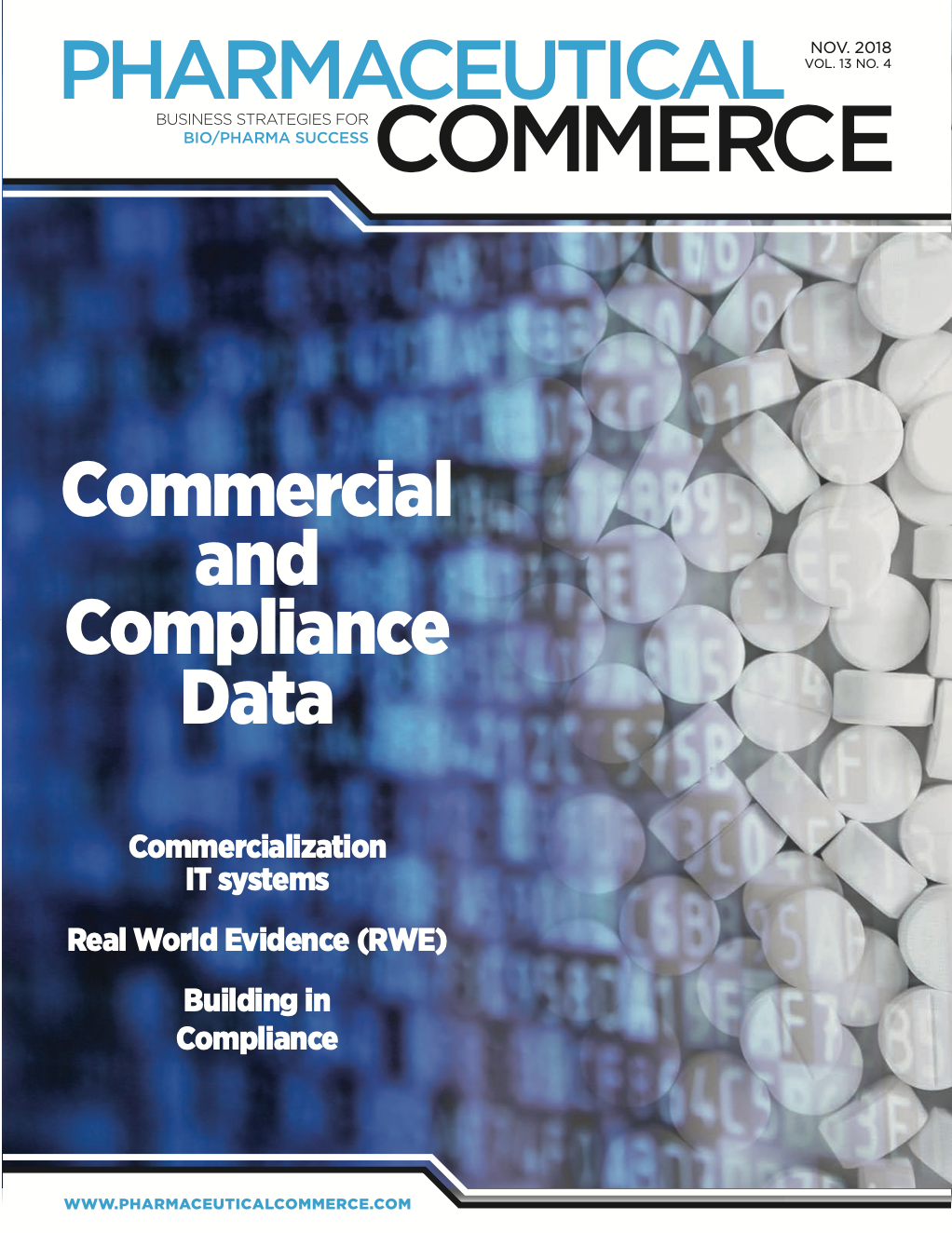Precision medicine and the importance of data
Patient-support Hub services are a vital repository of the patient journey
Click to view larger

Fig. 1. In CareMetx’ setup, its IT system both pulls in and pushes out data from pharmacies, HCPs and payers, delivering results to the patient and the manufacturer in a compliant manner so that the patient’s journey can be monitored. Credit: CareMetx[/caption]
As the pharmaceutical industry moves toward supporting precision medicine and providing patient specific treatments, the importance of contextualized data to support clinical decision has increased. Additionally, as new reimbursement and payment models continue to be explored with the increase in gene therapy treatments, it is no longer enough to know that a product has been dispensed to a patient. Manufacturers require better insight throughout the patient journey and are increasingly looking for a single ‘source of truth’ for the patient data and are requiring direct access to the data to ensure data quality and accuracy.
At the intersection of the patient’s treatment and reimbursement, the Patient Services Hub will maintain its importance as the central repository of data. The types of data collected, the methods of collection and ultimately the ability to understand what has been collected is increasingly the most critical role of the Hub.
Data types
Various types of data can be collected throughout the patient journey. In general, the data is either transactional and describes the various events that occur throughout the patient journey, or master data and describes the ‘who’ and ‘what’ such as the Patient, Product, etc. Before exploring the methods of collection, we must understand what can be collected.
Patient Demographics and Location refers to data associated with the patient details including name, gender, date of birth, Social Security Number, address, phone number, etc. When collecting, storing and transmitting or communicating this information to outside parties, it is important to take into consideration the HIPAA PHI (protected health information) guidelines as well as PII (personally identifiable information) guidelines.
Patient Insurance data indicates the patient’s Medical and Pharmacy benefit information. This may include not only the Primary insurance information, but also Secondary and supplemental insurance information. Because patients can change insurance carriers, this information may also indicate whether the insurance is still active.
Patient Communication Preferences have become important data points. No longer are we communicating only by phone or mail. In fact, some patients prefer to communicate by other digital means such as text or chat because their disease makes it difficult to communicate otherwise. Obtaining a patient’s preference for which method works best for them helps reduce response time and provides an overall better experience throughout the patient journey.
Healthcare Provider refers to the data associated with the provider details including name, NPI number, specialty, state license, Tax ID, location, etc. Additional information related to the relationship of the provider to the patient (i.e. prescribing provider, treating provider, specialist, etc.) may also be included to indicate the full scope of the patient’s care network.
Healthcare Facility Information refers to the name, address, NPI and other relevant data associated with the specific location where the healthcare provider and staff interacted with the patient. These can be sites of care or physicians’ offices.
Specialty Pharmacy data refers to the list of pharmacies that are in network. Data may also indicate which pharmacies dispense commercial or non-commercial (i.e. sample, bridge, PAP) type of product.
Patient Contact and Family refers to the name and contact information associated with individuals involved in the patient’s care network. These could be patient family members, guardians or other contacts. It may also indicate which specific individual is legally authorized to make decisions on the patient’s behalf. This is useful especially in cases when the patient is underage.
Patient Diagnosis indicates the patient’s diagnosis information. This could include primary as well as secondary diagnosis, along with information on when the patient was diagnosed.
Patient HIPAA Consent indicates whether the patient has consented to allow their information to be shared to third parties or even with the manufacturer. As the needs for precision medicine increases, it will be important to educate patients about the benefits of sharing data. Depending on state law, consents also expire after a certain period of time. So there will also be a need to reobtain consent on a regular basis to ensure that data can continue to be shared and maintained.
Prescription Information indicates the inscription and subscription along with the patient for which the prescription is written, and provider who is prescribing the medication.
Patient Clinical Data, if collected throughout the patient journey, can help determine if the patient is adherent and also be used in outcomes-based reimbursement and payment models.
As genetic-based treatments come into the market, Patient Qualitative Data which demonstrates the patient quality of life, may be used to support outcomes-based reimbursement and payment models.
Benefit Verification and Reimbursement Information includes overall benefit coverage for the patient as well as information specifically related to the product coverage. For example: is the product covered under the patient’s plan? what is the amount covered? is prior authorization required? which dispensing pharmacy will provide the lowest cost to the patient? This information is useful not only to direct the patient to the appropriate pharmacy for dispense, and determine if additional financial assistance is needed, but also for the manufacturer to determine where to direct their Payer Market Access efforts.
Product Inventory and Dispense Data is used to indicate if the product has been dispensed or if there was any issue at the pharmacy in trying to dispense the product.
Financial Assistance Information can cover various forms of financial assistance programs including Copay and Patient Assistance programs. It is useful to indicate how many patients qualified and how many took advantage of the program (i.e. dispensed the product) so that inventory and financial support can be taken into consideration.

The types of data described above can be collected and shared through various means by the hub. It is important to note that any type of data that is to be reportable for further analysis would need to be compiled into a database for processing.
Communicating via phone, mail or fax will require some form of manual data entry if further data analyses is required. As electronic forms of phone, fax or mail are used, certain meta data associated with the transaction would be stored (e.g. size, date of transmission, individual that initiated the transmission).
Data collected via web or mobile application includes electronic interfaces such as portals, EHR systems and other user interfaces that display or allow users to input data.
Data feeds allow data to flow from one application to another in a structured manner without manual intervention. These methods are typically used to also transfer data for the purposes of data aggregation. There are two types of data feeds. SFTP (Secure File Transfer Protocol) is a means of transferring files through upload or download between two computers or servers in a secure manner. Web Services are used when transferring data in real time. These typical protocols include REST API or SOAP API.
In the case of the CareMetx hub, data flows in and out of the hub using all of the above transmission methodologies.
Driving outcomes to support precision medicine
With the ever-increasing data needs to obtain patient level analysis, simply collecting and aggregating the data is not enough. With the rise in patient specific treatments, manufacturers will require a closer and more intimate knowledge of the patient and their journey. The focus and effort put into data aggregation and collection should always keep in mind the overall objective, which is to facilitate the full journey from patient identification and product administration to monitoring patient outcomes.
To ensure that the data retains its relevancy, integrity and quality, additional items need to be taken into consideration:
- Was the data transformed or altered prior to receipt? If so, why and how?
- At what point in the patient journey is the data being received?
- What is the purpose, intent and priority of the data in relation to the patient journey as well as the rest of the data inputs?
- Is there consistency in the reference data used to ensure comparisons between data across various systems are made appropriately? For example, something as simple as considering a patient to be Active on product in one system could be as soon as they are dispensed medication, whereas in another system they are Active when they call in to request assistance. Or it could be something associated with how Insurance Plans are categorized across systems?
Understanding the above will assist in adjusting the data aggregation and cleansing rules as reporting and analytics needs, as well as data sources and types, change.
As the legal and regulatory framework improves to allow data to be shared securely across different parties, and transmission standards and methods become widely accepted, manufacturers will be able to obtain additional data that can be used to further support their goal to provide patient specific treatment.
The hub will continue to play a central role in the collection, aggregation and integrity of data in order to help manufacturers navigate through changes in the patient journey.

Tanvi Kachhy, Vice President at CareMetx (www.CareMetx.com), leads the effort in advising and assisting clients in creating operational and technical solutions for their complex specialty therapies. She has over 15 years’ experience in developing solutions for the med device, digital health and telecommunications industries. Tanvi holds a BS electrical engineering degree from Rensselaer Polytechnic University.
